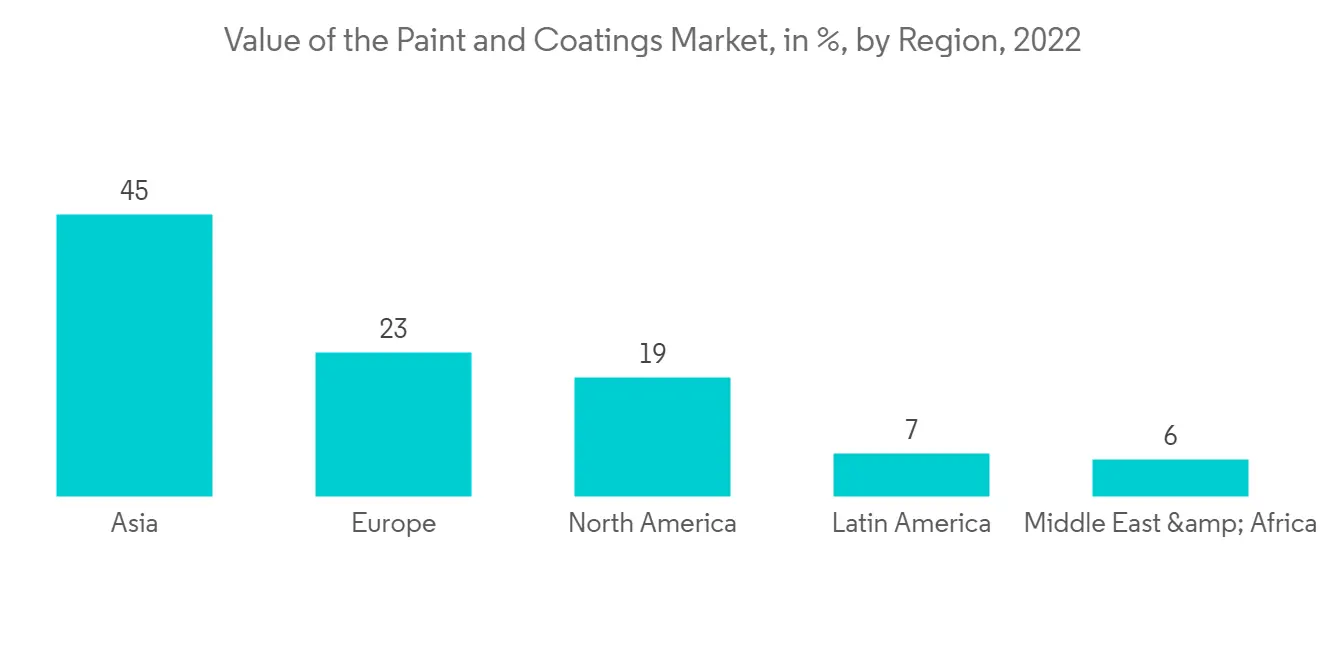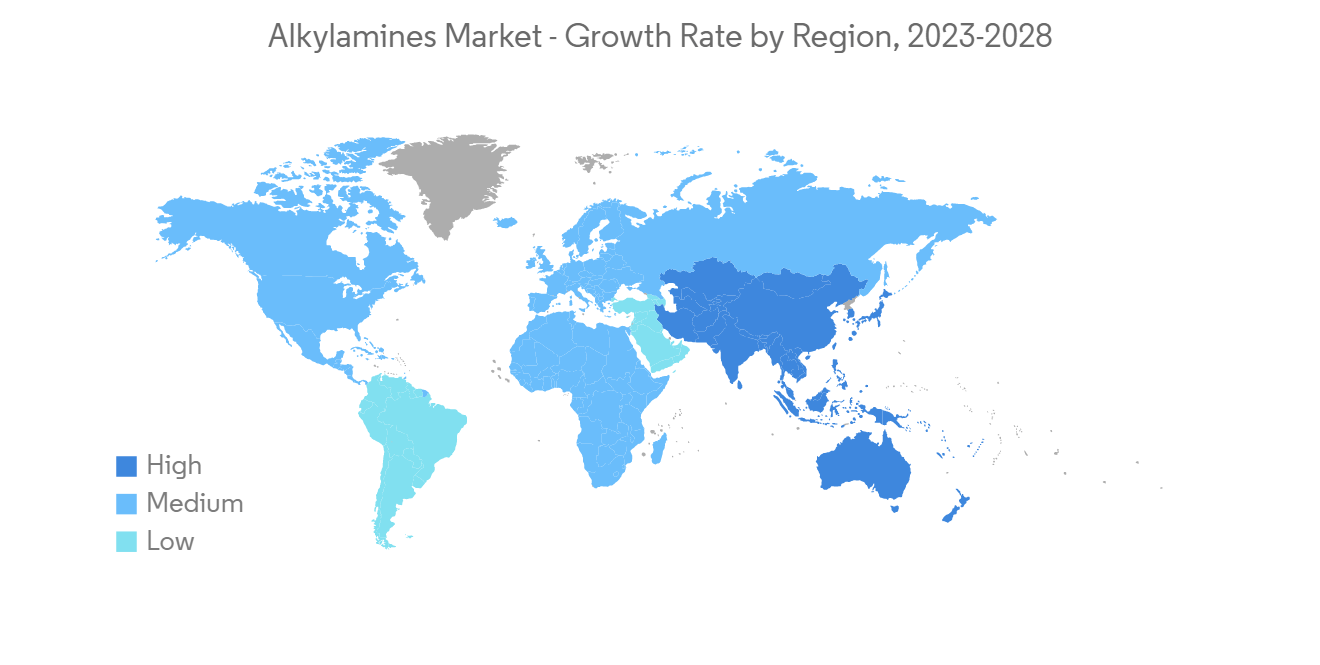 |
市場調查報告書
商品編碼
1272675
烷基胺市場 - COVID-19 的增長、趨勢、影響和預測 (2023-2028)Alkylamines Market - Growth, Trends, and Forecasts (2023 - 2028) |
||||||
※ 本網頁內容可能與最新版本有所差異。詳細情況請與我們聯繫。
在預測期內,烷基胺市場預計將以超過 6% 的複合年增長率增長。
由於生產設施暫時關閉,COVID-19 對該行業的發展產生了重大影響。 然而,新興國家紙漿和造紙行業的增長正在推動大流行後對烷基胺的需求。
主要亮點
- 油漆和塗料行業對烷基胺作為溶劑的需求不斷增長,預計將在預測期內推動市場需求。
- 地區政府和機構對交通部門的排放施加限制可能會減緩市場增長。
- 未來,市場應該會受益於製藥行業不斷湧現的新想法。
- 由於油漆和塗料行業的應用激增,亞太地區佔據了全球烷基胺市場的主導地位。
烷基胺市場趨勢
油漆和塗料行業對溶劑的需求不斷擴大
- 烷基胺主要用作油漆和塗層劑配方中的溶劑。
- 汽車、機械和建築等行業的發展正在推動對油漆和塗料的需求。
- 這主要是由於新興市場對新建築和其他工業應用的需求不斷增長。
- 溶劑越來越多地用於油漆和塗料,因為油漆質量越來越好,市場競爭越來越激烈,客戶偏好也在發生變化。
- 到 2021 年,全球油漆和塗料行業預計將增長到約 1600 億美元。 預計到 2029 年將達到約 2350 億美元。 市場主要受到建築行業需求增長的推動,木材、一般工業、汽車、卷材、航空航天、欄桿和包裝塗料市場也推動了需求增長。
- 到 2022 年,亞洲將成為全球最大的油漆和塗料市場,市場份額約為 45%。 歐洲和北美緊隨其後,分別佔 23% 和 19% 的份額。
- 建築行業是油漆和塗料的最大終端用戶行業。 中國政府預計建築業資本性支出同比增長7%以上。
- 根據立邦塗料集團的數據,2021 年中國整體油漆和塗料助劑市場規模將為 467 億美元。 2021 年,中國建築塗料製造商將生產 714 萬噸建築塗料,比 2020 年 COVID-19 爆發時增長 13% 以上。
- 印度塗料行業的價值超過 62,000 印度盧比(80 億美元),是世界上增長最快的主要塗料經濟體,在過去二十年中一直保持兩位數的增長。
- 這些東西應該會讓更多人想在未來幾年使用油漆和塗層劑(溶劑)。 預計這將在預測期內推動對烷基胺的需求。

亞太地區主導市場
- 亞太地區主導著全球市場份額。 中國、印度、日本和韓國等國家對油漆和塗料的需求不斷增長以及製藥業的發展增加了該地區烷基胺的使用。
- 中國是最大的烷基胺生產國和消費國,佔世界產能的絕大部分。
- 中國的醫藥市場位居世界第二。 預計到 2024 年將達到 1450 億美元,預測期內復合年增長率為 3.4%。
- 在預測期內,印度橡膠工業預計將從目前的 111 萬噸增長到 2023 年的 126 萬噸,複合年增長率為 2.5%。 預計這將增加印度對烷基胺的需求。
- 此外,中國和印度不斷發展的造紙和紙漿行業是烷基胺業務的主要推動力。 到 2022 年,中國紙和紙板製造市場將增長 5%,達到 2175 億美元。
- 亞太地區的烷基胺消費量佔全球總消費量的四分之三以上。 因此,預計亞太地區的新興國家將成為整個預測期內烷基胺市場增長的主要驅動力。

烷基胺行業概況
烷基胺市場部分分散。 烷基胺市場的主要參與者包括 BASF SE、Alkyl Amines Chemicals Ltd、Dow、Eastman Chemical Company、Hutsman Internetional LLC 等(排名不分先後)。
其他福利:
- Excel 格式的市場預測 (ME) 表
- 3 個月的分析師支持
內容
第一章介紹
- 調查結果
- 本次調查的假設
- 本次調查的範圍
第二章研究方法論
第 3 章執行摘要
第四章市場動態
- 主持人
- 油漆和塗料行業對溶劑的需求不斷擴大
- 新興國家/地區造紙和紙漿行業的增長
- 約束因素
- 各國政府在交通運輸領域的廢氣法規
- 工業價值鏈分析
- 波特的五力分析
- 新進入者的威脅
- 消費者的議價能力
- 供應商的議價能力
- 替代品的威脅
- 競爭對手之間的競爭強度
第 5 章市場細分(市場規模:基於金額)
- 產品類型
- 甲胺
- 乙胺
- 丙胺
- 丁胺
- 環己胺
- 用法
- 溶劑
- 橡膠
- 殺蟲劑
- 造紙化學品
- 燃料添加劑
- 醫藥
- 其他用途
- 地區
- 亞太地區
- 中國
- 印度
- 日本
- 韓國
- 其他亞太地區
- 北美
- 美國
- 墨西哥
- 加拿大
- 歐洲
- 德國
- 英國
- 法國
- 意大利
- 其他歐洲
- 南美洲
- 巴西
- 阿根廷
- 其他南美洲
- 中東和非洲
- 阿拉伯聯合酋長國
- 沙特阿拉伯
- 其他中東和非洲地區
- 亞太地區
第六章競爭格局
- 併購、合資、合作、合同等。
- 市場份額 (%)/排名分析
- 主要公司採用的策略
- 公司簡介
- Akzo Nobel NV
- Alkyl Amines Chemicals Ltd.
- Arkema Group
- BASF SE
- Eastman Chemical Company
- Hutsman International LLC
- Kao Corporation
- Mitsubishi Chemical Corporation
- Procter & Gamble
- Solvay
- Dow
第七章市場機會與未來趨勢
- 製藥領域的創新技術
- 其他機會
During the time frame of the forecast, the market for alkylamines is expected to grow at a CAGR of over 6%.
COVID-19 highly impacted industry growth owing to the temporary halt on production facilities. However, the growing pulp and paper industry in developing countries has propelled the demand for alkylamines post-pandemic.
Key Highlights
- The growing demand for alkylamines as solvents in the paints and coatings industry globally is expected to drive demand for the market during the forecast period.
- Regional governments and organizations that put limits on emissions in the transportation sector are likely to slow the growth of the market.
- In the future, the market should benefit from the fact that there are more and more new ideas in the pharmaceutical industry.
- Asia Pacific dominated the global alkylamines market owing to their surging application in the paint and coatings industry.
Alkylamines Market Trends
Growing Demand of Solvent in the Paints and Coatings Industry
- Alkylamines are primarily employed in the formulation of paints and coatings as solvents.
- Due to the growth of industries like automotive, machinery, and construction, there is a growing need for paints and coatings right now.
- Big companies in the paint and coatings business are growing and putting most of their attention on developing economies around the world.This is mostly because the demand for new buildings and other industrial uses is growing in developing countries.
- Solvents are being used in more and more paints and coatings because paints are getting better, the market is getting more and more competitive, and customer tastes are changing.
- The global paint and coatings industry will be worth approximately USD 160 billion in 2021. It is forecast to reach around USD 235 billion by 2029. The market is mainly driven by increasing demand in the construction industry, with the wood, general industrial, automotive, coil, aerospace, railing, and packaging coatings markets also driving demand growth.
- In 2022, Asia was the world's largest paint and coatings market, with a market share of approximately 45 percent. Europe and North America came next, each with a 23 and 19 percent share of the market.
- The building and construction industry is the largest end-user industry for paints and coatings. The Chinese government has projected the capital expenditure in construction to be over 7% higher than the previous years.
- According to Nippon Paint Group, China's overall paints and coatings market was valued at USD 46.7 billion in 2021. In 2021, Chinese manufacturers of architectural coatings will have made 7.14 million metric tons of architectural coatings, which is more than 13% more than when COVID-19 hit in 2020.
- The Indian paint industry is worth over INR 62,000 crores (USD 8 billion) and is the fastest-growing major paint economy in the world, with consistent double-digit growth over the last two decades.
- All of these things should make more people want to use paints and coatings (solvents) in the coming years. This, in turn, is expected to drive demand for the alkylamines during the forecast period.

Asia-Pacific to Dominate the Market
- The Asia-Pacific region dominated the global market share. With the growing demand for paints and coatings and the growing pharmaceutical industries in countries such as China, India, Japan, and South Korea, the usage of alkylamines is increasing in the region.
- China is the largest producer and consumer of alkylamines and accounts for a large chunk of the global capacity.
- China's pharmaceutical market is the second largest in the world. It is expected to reach USD 145 billion by 2024, which is a CAGR of 3.4% over the period of the forecast.
- During the period of the forecast, the Indian rubber industry is expected to grow at a CAGR of 2.5%, from 1.11 million metric tons of rubber now to 1.26 million metric tons in 2023. This will increase the demand for alkylamines in India.
- Also, the growing paper and pulp industries in China and India are a big driver of the alkylamines business.The market size of China's paper and paperboard manufacturing industry grew by five percent in 2022 to USD 217.5 billion.
- Asia-Pacific consumes more than three-fourths of the world's total alkylamine consumption. Hence, the developing countries of Asia-Pacific are expected to be the prime drivers of growth for the alkylamines market through the forecast period.

Alkylamines Industry Overview
The alkylamines market is partially fragmented. The key players in the allkylamines market include BASF SE, Alkyl Amines Chemicals Ltd, Dow, Eastman Chemical Company, and Hutsman Internetional LLC, among others (not in any particular order).
Additional Benefits:
- The market estimate (ME) sheet in Excel format
- 3 months of analyst support
TABLE OF CONTENTS
1 INTRODUCTION
- 1.1 Study Deliverables
- 1.2 Study Assumptions
- 1.3 Scope of the Study
2 RESEARCH METHODOLOGY
3 EXECUTIVE SUMMARY
4 MARKET DYNAMICS
- 4.1 Drivers
- 4.1.1 Growing Demand as Solvent in the Paints and Coatings Industry
- 4.1.2 Growing Pulp and Paper Industry in Developing Countries
- 4.2 Restraints
- 4.2.1 Emission Restrictions in the Transportation Sector by Various Governments
- 4.3 Industry Value-Chain Analysis
- 4.4 Porter's Five Forces Analysis
- 4.4.1 Threat of New Entrants
- 4.4.2 Bargaining Power of Consumers
- 4.4.3 Bargaining Power of Suppliers
- 4.4.4 Threat of Substitute Products/Services
- 4.4.5 Intensity of Competitive Rivalry
5 MARKET SEGMENTATION (Market Size in Value)
- 5.1 Product Type
- 5.1.1 Methylamines
- 5.1.2 Ethylamines
- 5.1.3 Propylamines
- 5.1.4 Butylamines
- 5.1.5 Cyclohexylamines
- 5.2 Application
- 5.2.1 Solvent
- 5.2.2 Rubber
- 5.2.3 Agrochemical
- 5.2.4 Paper Chemicals
- 5.2.5 Fuel Additives
- 5.2.6 Pharmaceuticals
- 5.2.7 Other Applications
- 5.3 Geography
- 5.3.1 Asia-Pacific
- 5.3.1.1 China
- 5.3.1.2 India
- 5.3.1.3 Japan
- 5.3.1.4 South Korea
- 5.3.1.5 Rest of Asia-Pacific
- 5.3.2 North America
- 5.3.2.1 United States
- 5.3.2.2 Mexico
- 5.3.2.3 Canada
- 5.3.3 Europe
- 5.3.3.1 Germany
- 5.3.3.2 United Kingdom
- 5.3.3.3 France
- 5.3.3.4 Italy
- 5.3.3.5 Rest of Europe
- 5.3.4 South America
- 5.3.4.1 Brazil
- 5.3.4.2 Argentina
- 5.3.4.3 Rest of South America
- 5.3.5 Middle East & Africa
- 5.3.5.1 United Arab Emirates
- 5.3.5.2 Saudi Arabia
- 5.3.5.3 Rest of Middle East & Africa
- 5.3.1 Asia-Pacific
6 COMPETITIVE LANDSCAPE
- 6.1 Mergers and Acquisitions, Joint Ventures, Collaborations, and Agreements
- 6.2 Market Share (%)**/Ranking Analysis
- 6.3 Strategies Adopted by Leading Players
- 6.4 Company Profiles
- 6.4.1 Akzo Nobel NV
- 6.4.2 Alkyl Amines Chemicals Ltd.
- 6.4.3 Arkema Group
- 6.4.4 BASF SE
- 6.4.5 Eastman Chemical Company
- 6.4.6 Hutsman International LLC
- 6.4.7 Kao Corporation
- 6.4.8 Mitsubishi Chemical Corporation
- 6.4.9 Procter & Gamble
- 6.4.10 Solvay
- 6.4.11 Dow
7 MARKET OPPORTUNITIES AND FUTURE TRENDS
- 7.1 Innovations in the Pharmaceutical Sector
- 7.2 Other Opportunities













